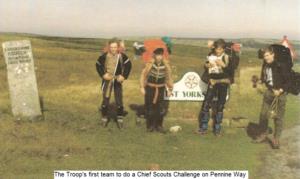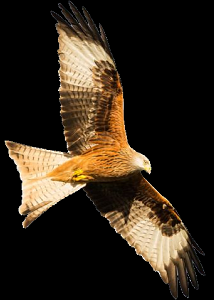

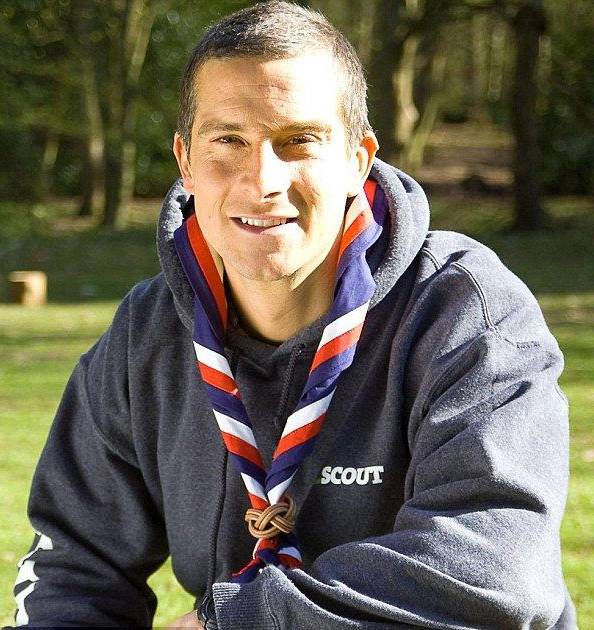
Everyone knows the Scouting movement was started by Baden-Powell but maybe not that it is as long ago as 1908.
My brother and I joined the Scouts in 1941. The first thing I remember vividly was at the Scout hut which, at the time, was the Rev. Stewart's garage. This was not being used as no-one had a car. Your attention was immediately drawn to a painting on the chimney-breast which was of a head and shoulders of a Boy Scout, complete with hat, woggle and neckerchief. I found out later that the outline drawing was done by my late uncle, Mr Stanley Rixon, and the painting was done by a Mr Maurice Saunders, known to all as Mosh. Both these Scouts had moved on to service for their King and country. I have been back to that garage and the painting has been whitewashed over.
The Scout troop consisted of two patrols. I was in the Woodpeckers and the other was the Hawks. Scouting activity was treated quite seriously, with cooking, learning how to tie knots and map-reading, so that different boys could earn different badges. Many friendly war-like games were played, one patrol against the other. I was told in later years by two of the boys who were at the siege of Kohima that their tracking and scrumping in the Scouts came in very handy when they had to crawl into the Jap lines at night to get water.
The dark evenings always had plenty of fun and amusement One evening the Hawks patrol was sent out to defend the cricket meadow. The Woodpeckers promptly disturbed a courting couple in a close clinch at the start when some of the Scouts rushed the old white cricket pavilion and some at the back disturbed the couple who were laid on the ground.
Another incident took place on what is now the main road when Scouts were told to look out for a person heavily disguised and probably limping and to "capture" him. The person happened to be old Mr John Saunders, limping his way down to the Crown pub for a pint. He had a few harsh words, wielding his walking stick and the boys retreated post haste.
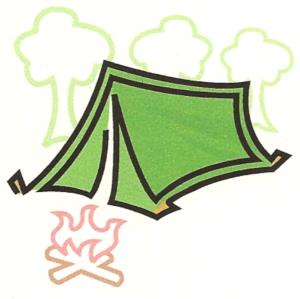
A sad affair concerned an old lady with a wizened face and no teeth who always wore a beret and collected wood which she carried home on her back- one Mrs Rose Bowler. We had organised a game in the green meadow (now the new road passes through the middle of it) where she was wooding. She told us she had lost her brooch and we were on our hands and knees in line like a police force searching for it but sadly never found it.
Another activity took place at Turnip End. I personally had the experience of being pushed into the pond and another Scout came along and pushed the one who had pushed me in too -we both got out laughing.
Other activities included cross-country running and a large gathering of patrols met one Saturday afternoon for a cross-country challenge. I was called at only three days notice to replace someone who had dropped out and I think I came in 47th out of 50. Another memory was attending a rather large jamboree at a park in Oxford where the Chief Scout, Lord Rowallan was present.
One incident took place with an amusing side. We went on August Bank Holiday weekend camp in 1944 at Waterstock-cum-Ickford. We caught the train from Princes Risborough to Tiddington and had a long walk carrying our kit-bags to camp near the River Thame. It was at the time when the doodle-bugs were falling in the area. One of the farmer's cows got upset and got stuck in the river. The farmer came to the camp to ask for volunteers to help pull the cow out of the river. The bigger boys went to help and some of us were left to cook Sunday lunch. In the activities that followed the billy-cans got knocked over and only some of the food was saved. This was given to the Scout leaders - we never did tell them we went without Sunday lunch.
Another area of great interest to scouts was a field leading from Lacey Green to Turnip End containing Nanny Cooper's pond. The pond itself was of great interest to boys as they climbed along the branches over the water and took great delight in falling into the pond. Sadly we lost the pond when the trees were cut down and the pond filled in to provide the airfield.
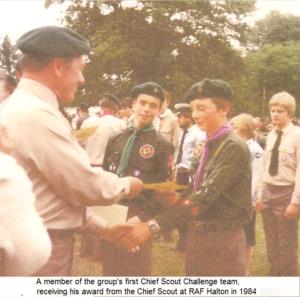
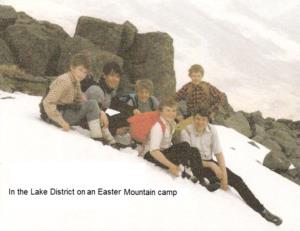
I became involved with Scouting in Lacey Green in 1980. There was a thriving cub group in the village, under the leadership of John Munday, who was assisted by Brian Biggs and Arthur Watters. At age 11 the boys needed to move onto Scouts and there was no group for them, so with sons aged 11 yrs and 9 yrs respectively I felt I ought to perhaps do something about it and Arthur Watters agreed to share the responsibility with me.
I had been in scouting in my youth, but needed to be brought up to date, if I was to do the job properly. First of all I did a weekend training course in High Wycombe, followed by a further training course in Hampshire and finally I went to Gilwell Park for a week, in order to gain my leader's 'Wood Badge' qualification.
We began the troop with about a dozen boys, mostly from the cubs, but with a few more from outside the village. Initially we met in the school hall, but we really needed a place of our own and John West kindly offered a site on his land at Kingswood Farm. We had been offered a redundant building from a firm in Marlow, which we could have at no cost, if we were prepared to break it down and reassemble it in situ at Kingswood. Over a few months this duly happened and it remained the headquarters for a couple of years until Lacey Green and Speen Scouts amalgamated. We then met in the established Scout hut at Speen, which had its own surrounding woodland, which lent itself to all Scouting activities. We were able to do some adventurous pioneering and enjoyed cooking over wood fires etc.
A favourite activity with boys was to go down to the National Scout Boating Centre at Marlow, where we occasionally camped for the weekend. Canoeing, sailing in topper dinghies and pioneering in a 'breeches buoy' from the island to the river bank were popular activities. Sometimes we took the boys to Handy Cross for the climbing and abseiling wall and always participated in the annual swimming gala at Stoke Mandeville.
Over the years the boys worked towards various badges, attended jamborees and Easter mountain camps in Wales and the Lake District. Many of the boys achieved their Chief Scout Challenge, which involved teams of four doing an adventurous walk, in such places as the Brecon Beacons, The Pennines and the North York Moors. During the walk they had to study the area they went through and on return give a presentation to the district leaders, explaining the historical and geographical features of the area. The walk lasted three days and two nights and the boys had to be self-sufficient in all aspects of camping. Some of the boys attending a jamboree at RAF Halton, which the Chief Scout also attended, were the first boys he had seen to have completed his newly introduced Challenge.
Over the years while I was Group Scout leader the cubs continued under a succession of leaders including Margaret Gray, who was cub leader for many years. Also other parents, mainly mothers, helped to keep the group running. However, eventually we reached a stage where it was difficult to find leaders and so then when I moved out of the district in 1996, I was not replaced and unfortunately Lacey Green and Speen Scouts more or less came to an end.
